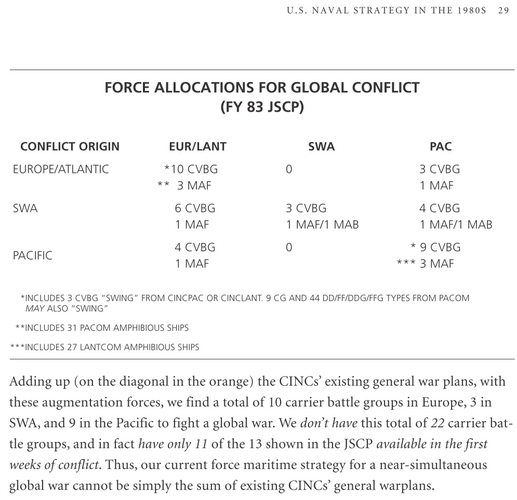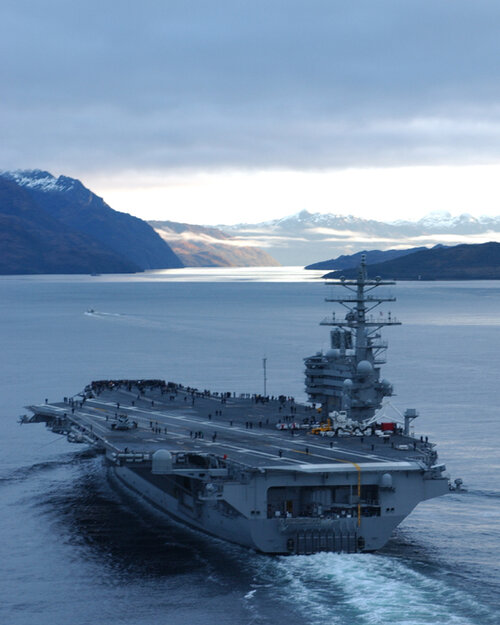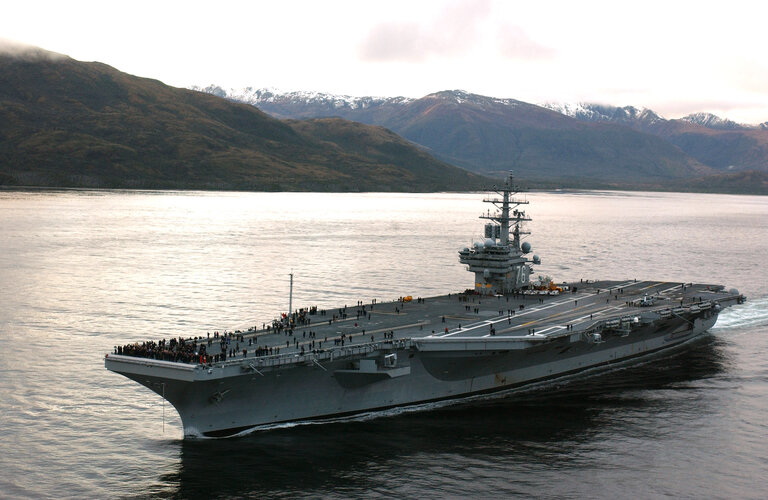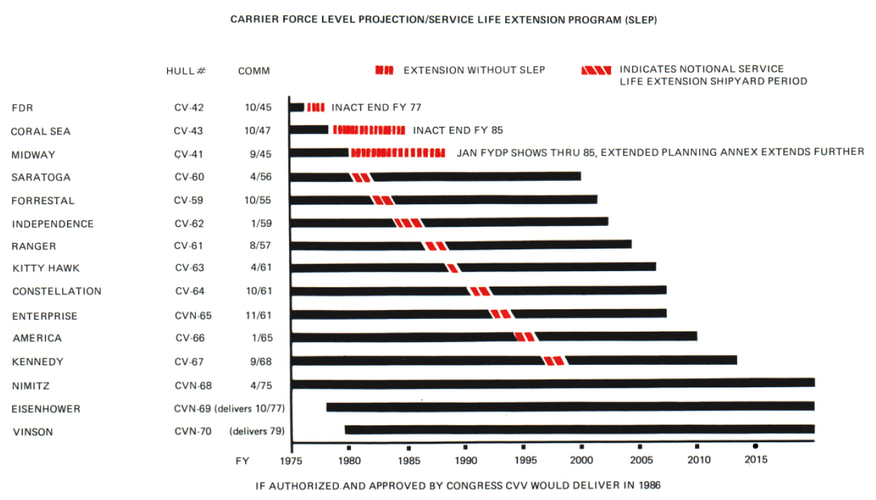- 1992 - Coral Sea - Actually retired 1990, 2 Years Early.
- 1997 - Midway - Actually retired 1992, 5 Years Early.
- 2000 - Forrestal - Actually retired 1993, 7 Years Early.
- 2001- Saratoga - Actually Retired 1994, 7 Years Early.
- 2002 - Ranger - Actually Retired 1993, 9 Years Early. Replaced by USS George Washington CVN-73
- 2004 - Independence - Actually Retired 1998, 6 Years Early. Replaced by USS Harry S Truman CVN-75
- 2006 - Kitty Hawk - Actually Retired 2009, 3 years late. Replaced by USS George H.W. Bush CVN-77
- 2006 - Constellation - Actually Retired 2003, 3 years early. Replaced by USS Ronald Reagan CVN-76
- 2006 - Enterprise - Actually Retired 2017, 11 years late. Replaced by USS GRF CVN-79
- 2010 - America - Actually Retired 1996, 14 Years Early. Replaced by USS John C Stennis CVN-74
- 2013 - John F Kennedy - Actually Retired 2007, 6 Years Early.
When they were initially discussed for the FY88-89 budget CVN-74 (to become
John C. Stennis) was to replace USS
Midway and CVN-75 (to become
Harry S. Truman) was to replace one of the Forrestals, presumed at that time to be
Saratoga.
As initially planned
Enterprise was to undergo her "complex overhaul" (which was effective a SLEP for the CVN fleet) during 1993-96 taking 42 months.
The SLEPs for
America and
John F. Kennedy were scheduled for April 1996-May 1999 and January 1999-February 2002. Interestingly their planned decommissioning dates of 2010 and 2012 gives a 10-year life extension rather than 15 of the earlier SLEPs, I guess due to general material condition at that stage of their lives.
Ranger's SLEP always seems to have been in doubt, tied up with the decision to go with replacements every three years with new construction (the CVN-74 and CVN-75 order).
As to cruisers, the Virginias should have completed their NTU upgrades by FY1995, as we know the decision was taken not to do this and decommission instead. The NTU work for these ships would have been upgrades to Mk 74 MFCS and SPG-51D, improvements to the Mk 26 launchers and replacing SPS-40B with SPS-49.
Long Beach should also have completed her NTU by FY95, with updated SPG-55D and Mk 10 launchers and SPS-48E added. It seems that it was the refuelling costs that influenced the decision to decommission these ships because the NTU work was relatively minor given the other prior weapon and systems updates already made to these vessels.
There were tentative plans (under pressure from Congress) to begin a SLEP programme for the Knox-class from 1989 but I don't think that this was ever begun.
The two Raleigh-class LPDs were to have been modernised to extend their lives to 1997-98 but this never happened either and they were decommissioned in 1991-92.
As to support ships, it had been planned to build 15 Supply-class AOEs, one per carrier, but this never happened and only 4 were completed.
I find it hard to believe that
Saratoga was the
Forrestal-class destined to be replaced by CVN-75. The Navy briefly planned to (and to a degree did) have USS
Forrestal replace
Lexington in the training carrier role in 1992. I think she only served this role briefly for a few months before this plan was scrapped. I think she was redesignated, and even showed up to Pensacola but nothing happened beyond that. Kinda curious if this plan had gone thru if she’d still be in-service today.
I assume the post-SLEP lifespan for the
American and
JFK were conservative estimates based on a belief Nimitz-production would catch up to replace them. Considering what we know now, especially in regards to what happened to USS
Enterprise and is happening to USS
Nimitz, I wouldn’t be surprised if
America was decommissioned in ~2015, and if
JFK wasn’t decommissioned until ~2020. Not needing nuclear refueling would make them prime candidates to extend their lifespans, hell I think that’s the main reason
JFK and
Kitty Hawk sat so long in mothballs. The main question I think revolves around what CVN construction between 2010-2020 would’ve been. Would we have built more advanced
Nimitz-class like the
Bush, or would the GRF-class be less…ambitious in its design goals, leading to fewer delays and issues?
Also, I forgot about
Ranger. Her SLEP was for 1993 according to my source, with a retirement of 2002. Which, to your point is surprisingly short. If any
Forrestal-class would be retired, I’d assume it’d be her. But hell, the
Midway wasn’t expected to be retired until 1997. Would be hard to justify retiring
Ranger before
Midway.
As far as the cruisers go, I want to believe in this alternate scenario that
Long Beach received AEGIS upgrade. Is this realistic? Probably not, but it’s like the hypothetical 1944 HMS
Hood refit (have you seen Tzoli’s designs? Ugh. So good). Sure it wasn’t going to happen, but damn I wish it did just for the cool factor.
As far as the other cruisers go- considering how immensely successful the
Arleigh Burke-class turned out to be, I still consider a strong possibility that the other CGN are retired early. I don’t have an exact quote atm about annual operating costs, but iirc they cost twice that of the
Arleigh Burke. Why dump resources into operating expensive NTU nuclear cruisers, when the
Arleigh Burke-class is cheaper and more capable. Hell, that’s ultimately what befell the LCS program. The
Burke is just such a good effing design.
As far as the air wing conversation goes- I’ve never read that deeply into the ATF/A-12 Avenger program. I know it was an expensive program, but I personally believe that was just the nature of developing stealth aircraft especially in the 1990s, rather then mismanagement on behalf of Grumman. And I think if the USSR built
Ulyanovsk plus a 5th Gen Fighter (maybe derived from MiG 1.44?), Congress would be more inclined to support a stealth attack aircraft.
Like I mentioned before, I have a personal bias against the Super Hornet. I think the F-14 platform was far more capable. It our timeline, an updated F-14 would be comparable to the F-15E which has enjoyed a particuarly long lifespan. However, it’s arguable that the F-15 has only had such a long lifespan because of the early cancellation of the F-22 which only occurred because of the collapse of the USSR. So it’s likely that the F-15 would’ve been phased out in this alternate universe, and so to would the F-14.
The Navy didn’t wind up getting a stealth platform until the F-35C entered service in the 2010s. If the USSR was still around, I’d argue a further emphasis would be placed on developing a stealthy naval air superiority aircraft to replace the F-14. The Sea Raptor is the most obvious candidate, but who knows. Regardless of the specific winner, I’d argue that a stealthy naval fighter would’ve been a higher priority and entered service in the mid-00s.
I do want to pivot some of the conversation towards hypotheticals following September 11th. The War on Terror completely changed our procurement, and I’m curious to hear some discussion regarding what people would consider to be most likely in a world where the USSR still existed. Robert Gates made some god awful decisions, mostly due to a perceived lack of geopolitical adversary. However, by 2001, the Soviet Union may have been able to economically recover from its recession and entering a resurgence.
The most obvious change that I can think of would be the F-22 procurement not being cancelled. But Naval wise, I’m curious what you guys think would happen? LCS never happen? Zumwalt?




